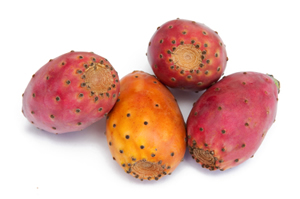Prickly Pear Opuntia ficus-indica

prickly pear fruits
- Common Names
- Prickly Pear , Nopales, Nopal, Indian fig
- Botanical Name
- Opuntia ficus-indica
- Family
- CACTACEAE
Medicinal Uses & Benefits of Prickly Pear
![]() How to Use|
Side Effects |
Plant & Garden|
How to Use|
Side Effects |
Plant & Garden|
- Medicinal Uses: * Diabetes
* Diet/weight Loss
* South_American
- Properties: * Appetite Depressant
- Parts Used: Fruit, pads and fruit juice
- Constituents: flavonoids, such as quercetin, kaempferol, and isorhamnetin betalains, carotenoids, and polyphenols calcium, magnesium, and eight essential amino acids. pectin and water-soluble fiber
How to Use: Prickly Pear
Prickly pear is a plant in the cactus family used in traditional Mexican cooking and medicine. Prickly pear cacti are a source of calcium, magnesium, and eight essential amino acids. Pectin and water-soluble fiber from prickly pear cacti is effective in treating problems associated with diabetes and obesity, including the regulation of blood sugar and low-density lipoprotein (LDL) metabolism. Antioxidants found in prickly pear cactus include pigments such as betalains, flavonoids, and carotenoids, as well as vitamin C. 1
Preparation Methods & Dosage :The fresh and canned fruit is available at food markets. Nopal juice and supplements are available at health food stores and on line. Follow package directions.
Prickly Pear Remedies
Prickly Pear Side Effects: Safe for food use. Safety in pregnancy is not established. Monitor your blood sugar carefully if you have diabetes and use prickly pear cactus
Plant Description
The genus Opuntia includes approximately 200 species, many of which produce colorful edible prickly pear fruit and edible cladodes (modified stems) known as nopales or young nopalitos. Indian fig cactus (Opuntia ficus-indica) is the most common culinary species. Prickly pear cacti are cultivated in many countries, including Mediterranean nations, Mexico, Argentina, Brazil, China, and Korea. 1
Regional Traditions :Central and South America * North America *
History and Traditions & Folklore
Prickly pear was widely used as long as 6,000 years ago by Native Americans particularly in Northern Mexico and Arizona areas.- Hasse C, Feistel B, Felker P, et al. "Opuntia - a cactus crop and its many health benefits." NutraCos. Sep/Oct 2008: 17-22.
American Botanical Council
Studies have demonstrated the hypoglycemic effects of the cladodes on non-diabetic animals and diabetic animals and humans. One animal study has found that a combination of insulin and a prickly pear cactus (O. fuliginosa) extract lowers glucose levels to normal with a lower dose than insulin alone.
.











